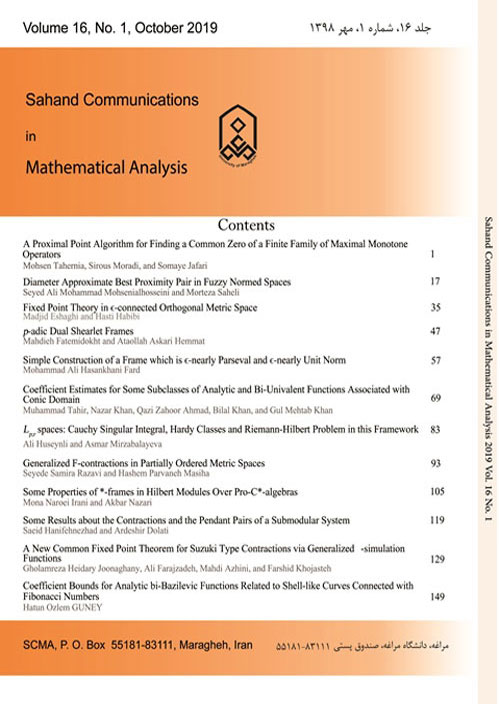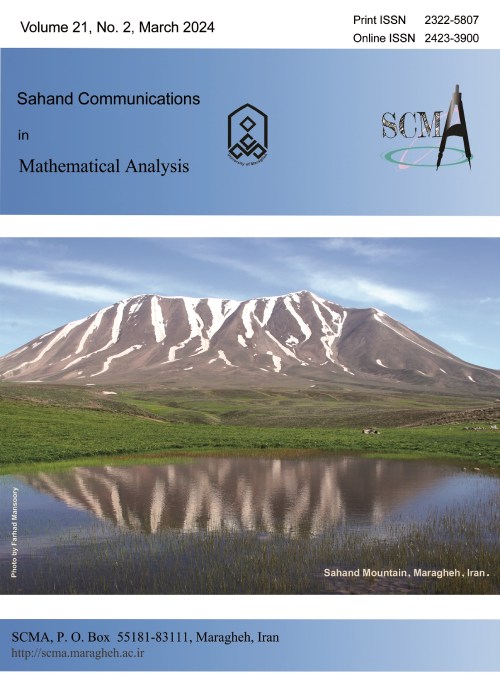فهرست مطالب

Sahand Communications in Mathematical Analysis
Volume:19 Issue: 3, Summer 2022
- تاریخ انتشار: 1401/08/07
- تعداد عناوین: 10
-
-
Pages 1-12
S. Karkaus, K. Demirci, and O. Duman in 2008 studied the statistical convergence of a single sequence over Intuitionistic fuzzy normed space(\textbf{IFNS}). M. Mursaleen in 2009, generalized the above work for double sequences over IFNS. The present article is the study of statistical convergence of triple sequence and triple Cauchy sequences on IFNS. In addition, the article includes examples in support of some definitions and theorems. Furthermore, we examined the proof of the completeness of special sequence space.
Keywords: Triple sequence, Statistical convergence, Intuitionistic fuzzy normed spaces, -norm -conorm, Statistical Cauchy sequences -
Pages 13-33
In this paper, we investigate approximations of the $k-th$ partial ternary cubic derivations on non-Archimedean $\ell$-fuzzy Banach ternary algebras and non-Archimedean $\ell$-fuzzy $C^{*}$-ternary algebras. First, we study non-Archimedean and $\ell$-fuzzy spaces, and then prove the stability of partial ternary cubic $*$-derivations on non-Archimedean $\ell$-fuzzy $C^{*}$-ternary algebras. We therefore provide a link among different disciplines: fuzzy set theory, lattice theory, non-Archimedean spaces, and mathematical analysis.
Keywords: Partial ternary derivation, Cubic derivation, Non-Archimedean, fuzzy algebra, ternary algebra, Hyers-Ulam-Rasias stability -
Pages 35-53
In the present work, we investigate an interval of real parameters $ \lambda $ for which the problem admits at least one nontrivial solution. Moreover we deal with the existence results of three solutions for anisotropic problems with variable exponents.
Keywords: Neumann problem, Three weak solutions, Anisotropic variable exponent problems -
Pages 55-63
In this paper, we are going to introduce an approach to convert the topology of a topological space to another topology (in fact, a coarser topology). For this purpose, we consider a topological space $(X, \tau)$ with a closed point $p$ of its points. Using a grill $\mathcal{G}$ on the space $(X, \tau)$ and the closure operator associated with $\tau$, we define a Kuratowski closure operator $cl^*_p$ on $X$ to create the desired topology. We then characterize the form of this resulting topology and also determine its relationship to the initial topology of the space.
Keywords: Kuratowski closure operator, Grill, Coarster topology, Extension topology, One-point extension topology -
Pages 65-76
In the present paper, we compute the conservation laws of the Vaidya-Bonner geodesic space-time metric in aRiemannian space and carry out the moving frame method for this metric. We obtain the connection forms andcurvature 2-forms, using the first and second Cartan's structure equations. Finally, the Ricci scalar tensor and the components of Einstein curvature are calculated.
Keywords: Conservation laws, Geodesic, Riemannian metric, Moving frame -
Pages 77-92
In this paper, the notion of $ps-ro$ $\beta$-open (closed) fuzzy sets on a fuzzy topological space($fts$) has been introduced as a new tool to study $fts$, the properties of these sets are investigated and shown to be unrelated to the common concept of fuzzy $\beta$-open (closed) sets. Based on these fuzzy sets, $ps-ro$ fuzzy $\beta$-continuity and $ps-ro$ fuzzy $\beta$-open (closed) functions are proposed and they are also found to be different from the idea of fuzzy $\beta$-continuous and fuzzy $\beta$-open (closed) functions, respectively. Further, their characterizations and relationships with existing allied concepts are investigated.
Keywords: Fuzzy -open, Pseudo regular open fuzzy topology, -open(closed) fuzzy sets, fuzzy, continuity, open(closed) function -
Pages 93-109
This paper deals with the existence and uniqueness of the mild solution of the fractional integro-differential equations with non-instantaneous impulses and state-dependent delay. Our arguments are based on the fixed point theory. Finally, an example to confirm of the results is provided.
Keywords: Non-instantaneous impulses, Fractional integro-differential equations, Fixed point, Caputo Fractional derivative, State-dependent delay -
Pages 111-124
The inherent feature of real-world data is uncertainty. If data is generated in valid experiments or standard collections, probability theory or fuzzy theory is a powerful tool for analyzing them. But data is not always reliable, especially when it is not possible to perform a reliable test or data collection multiple times. In this situations, referring to the beliefs of experts in the field in question is an alternative approach and uncertainty theory is a tool by which the beliefs of experts can be mathematically incorporated into the problem-solving structure. In this paper, we investigate the finding minimum weighted maximal matching with uncertain weights. For this purpose, we offer two methods. In the first method, by introducing the concept of chance constraint, we obtain model with definite coefficients. The second method is based on the concept of uncertain expected value. Finally, a numerical example for these two methods is presented.
Keywords: Uncertainty theory, Graph, Maximal matching, Integer programming -
Pages 125-139
Let $ \mathcal{B}_1$ denote the closed unit ball of $\mathcal B(H)$, the von Neumann algebra of all bounded linear operators on a complex Hilbert space $H$ with $\dim H\geq 2$. Suppose that $\phi$ is a bijection on $ \mathcal{B}_1$ (with no linearity assumption) satisfying\begin{equation*}\phi(AB^{*}A)=\phi(A)\phi(B)^{*}\phi(A), \quad( A, B\in \mathcal{B}_1).\end{equation*}If $I$ and $\mathbb T$ denote the identity operator on $H$ and the unit circle in $\mathbb C$, respectively and if $\phi$ is continuous on $\{\lambda I: \lambda\in \mathbb T\}$, then we show that $\phi(I)$ is a unitary operator and $\phi(I)\phi$ extends to a linear or conjugate linear Jordan $^*$-automorphism on $\mathcal B(H)$. As a consequence, there is either a unitary or an antiunitary operator $U$ on $H$ such that $\phi(A)=\phi(I) UAU^*$, $(A\in {\mathcal B}_1)$ or $ \phi(A)=\phi(I) UA^*U^*$, $(A\in {\mathcal B}_1)$.
Keywords: Hilbert space, Jordan triple product, Effect, Preserver map -
Pages 141-168
In this paper, we express and prove Bushell-Okrasiaski, Hardy and Minkowski type inequalities for two classes of pseudo-integrals. One of them, classes with pseudo-integrals where pseudo-operations are defined via a monotone and continuous generator function. The other one concerns the pseudo-integrals based on a semiring with an idempotent addition and a pseudo-multiplication generator. Those are important inequalities from both mathematical and application points of view. The established results are based on the classical Bushell-Okrasiaski, Hardy and Minkowski's inequalities for integrals. Also, some examples and applications are presented.
Keywords: B-O type inequality, Convolution type inequality, Hardy type inequality, Minkowski's inequality, Fuzzy integral inequality, Pseudo-integrals


